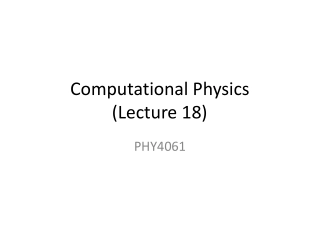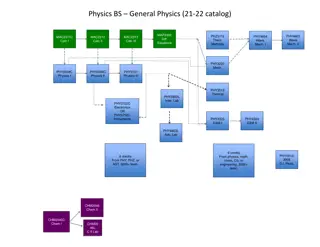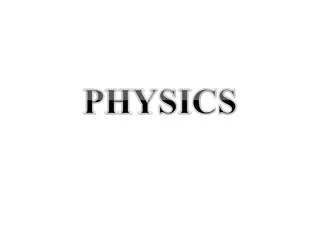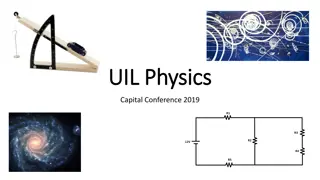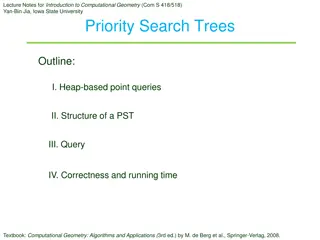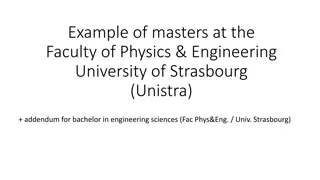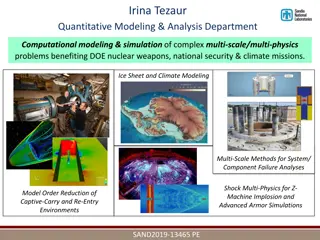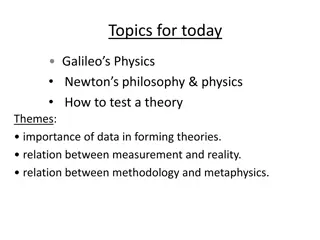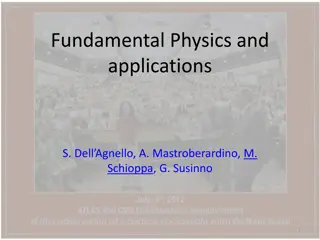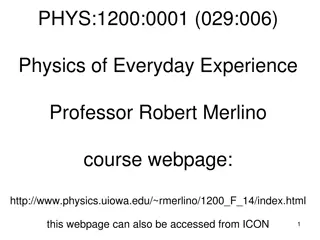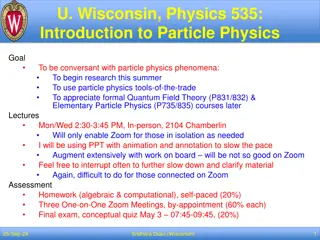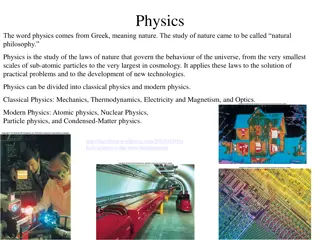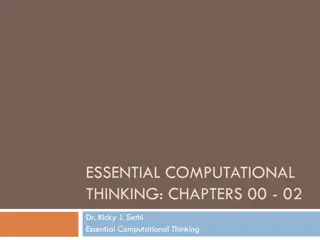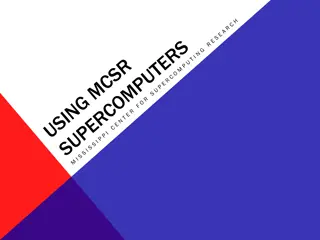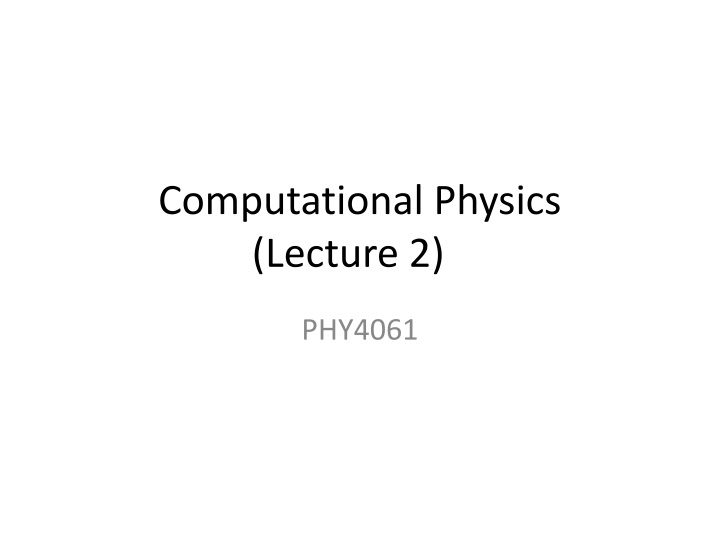
Understanding Randomness in Computational Physics
Learn about good and bad approximations in simulations, the properties of random numbers, generating true random numbers, deterministic sequences, and alternative methods for generating randomness. Explore the importance of randomness in computational physics and the challenges in achieving it accurately.
Download Presentation

Please find below an Image/Link to download the presentation.
The content on the website is provided AS IS for your information and personal use only. It may not be sold, licensed, or shared on other websites without obtaining consent from the author. If you encounter any issues during the download, it is possible that the publisher has removed the file from their server.
You are allowed to download the files provided on this website for personal or commercial use, subject to the condition that they are used lawfully. All files are the property of their respective owners.
The content on the website is provided AS IS for your information and personal use only. It may not be sold, licensed, or shared on other websites without obtaining consent from the author.
E N D
Presentation Transcript
Computational Physics (Lecture 2) PHY4061
Good approximation vs. bad approximation One example of a bad simulation. What went wrong? Could it become a good approximation? Good approximation is good physics.
Random number generation Randomness a property of an infinite sequence xiwith i = 1, 2, . . . . Impossible to tell whether a single number is random or not. A negative property, it is the absence of any order. Can we truly test certain sequence of data is random or not? Uniform distribution Uniformly distributed in the range of (0,1) or (1, 2M) The prediction of a very smart person is not better than average. Rock paper scissor game. John Nash s equilibria: a mix of strategies always exists where no single player can do any better by changing their own strategy alone. https://www.quantamagazine.org/the-game-theory-math-behind-rock-paper-scissors- 20180402/ Question: Are there game without Nash s equilibria? Question: Can you generate true random numbers using a computer?
Desired properties of random numbers Determinism. odd property for a random sequence if it is deterministic, one can predict with certainty the next number, if you know the algorithm. Useful property for debugging! Computers as they are now constructed are deterministic. The only possibilities for randomness are to read an "external" device, the microsecond clock or a very unreliable memory. This is not done too slow and too expensive. Any other problems for such random numbers?
Russian mathematician Ilya M. Sobol: "A random variable that satisfactorily describes a physical quantity in one type of phenomenon may prove unsatisfactory when used to describe the same quantity in other phenomena". Question: any other ways to generate random numbers, instead of reading external devices or using pseudo random number generators?
Tables of Random Numbers Very simple Just like shuffling cards. Suppose: you write each number from 0 to 99 on a card, put all the cards in a hat shake it and draw all the cards from this hat one by one you end up with a sequence of 100 random numbers.
To use these numbers in a program, you can store them in memory the same order in which they were picked from the hat create a global variable to keep track the next random number that can be used from that table. Problems of this method?
Simple code: short rand[100] = {16, 55, 30, 12, 3, 92, ... }; int counter = 0; int N = 32; for (int i = 0; i < N; ++i) { short randNumber = rand[counter++]; ... }
In 1955, Rand Corporation released a sequence of 1 million random digits. It is the longest sequence of random numbers ever published! Also probably the most boring book ever.
Introduction to Crystal structure Reference books: Any solid state physics text books, Kittel s or Kun Huang s for example.
Crystal structure Periodically placed building blocks (atoms, molecules, ions ) Translational symmetry of the basis Proved by X-ray diffractions Crystal: basis + lattice Or basis in the primitive cell + Bravais lattice Why many high quality solid samples have long range ordering at low temperature?
Bravais Lattices A regular periodic arrangement of points in space. tn=n1t1+n2t2+n3t3 t1, t2,t3: primitive vectors n1, n2, n3: integers t1, t2, t3 form primitive cells. Volume of primitive cell: V= t1 (t2xt3) Right handed system The primitive cell contains one lattice point, smallest cell Question: The choice of the primitive vectors is unique or not?
The choice of the primitive vectors is unique or not? t1 = (a, 0, 0); t2 = (0, b, 0) t1 = (2a, -b,0); t2 = (-a, b, 0) 2 1 1 1 ?? Unit determinant of the transformation matrix Therefore the volume is independent of the primitive vectors ?? ?? = ??
Unit Cell Possible to describe the whole lattice using non-primitive cells => unit cell. One example: t1 =(a, 0, 0) t2 = (a/2, b/2, 0) t1c = (a, 0, 0) t2c=(0, b, 0) 1 0 1 2 When to use primitive cell and when to use unit cell? Full translation symmetry: use primitive cell Wave vector quantum number, Brillouin zone concept ?1? ?2?= ?1 ?2
1 oblique (1, 2), 2 rectangular (1m 2mm) including 3 centered rectangular (rhombic) , 4 hexagonal (3, 3m, 6, 6mm) , 5 square (4, 4m) File:2d-bravais.svg
Diamond and Zincblende
ABABAB stacking Packing fraction: the maximum ratio of the volume of hard balls that occupy the lattice points to the total volume Graphene (Scienc 306,666,2004)
Geometrical description and primitive cell of some crystal structures Fcc: t1 = a/2(0,1,1) t2= a/2(1,0,1) t3=a/2(1,1,0) Bcc: t1 = a/2(-1,1,1) t2= a/2(1,- 1,1) t3=a/2(1,1,-1)
NaCl: t1 = a/2(0,1,1) t2= a/2(1,0,1) t3=a/2(1,1,0), d1 = 0, d2 = a/2(1,1,1) Diamond structure and zincblende structure t1 = a/2(0,1,1) t2= a/2(1,0,1) t3=a/2(1,1,0), d1 = 0, d2 = a/4(1,1,1)
Crystal direction equivalent: <l1l2l3> By convention, negative index are written with a bar, as in 3 for 3 Crystal planes (h1,h2,h3) a1/ h1 a2/ h2 equivalent {h1,h2,h3} [l1,l2,l3] l1 a1+l2 a2+l3 a3 Miller index a3/ h3. a1 a2 a3 are unit cell vectors!
Sample code for a simple cubic lattice Input: cell size (Lx Ly Lz) = (nx ny nz)a3 , a --- lattice constant. Sc: Na = 0 (no. of atoms) i=1, nx j=1, ny k=1, nz Na = Na +1 x(Na) = 0.0 + (i-1)*a y(Na) = 0.0 + (j-1)*a z(Na) = 0.0 + (k-1)*a Next k Next j Next i Nt(Sc) = Na (total no. of Sc atoms)
Project A part I: Programming Sc, Bcc, Fcc, and Diamond crystalline structures. Detailed requirements: The simulation cell size is adjustable in both periodicity and lattice constant. The shape of the cell has to be cubic like (or tetragonal). Make sure to include correct number of atoms in your cell. Plot the structure using any graphic software, like VMD Score will be deducted if the program has bad variable/function naming conventions or without adequate comments. Email the code and output to TA directly. Project is due two weeks after the lab. Score will be deducted if the submission is late.

